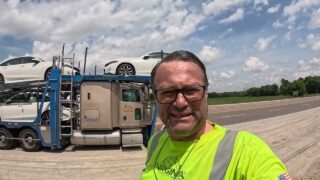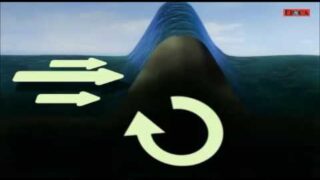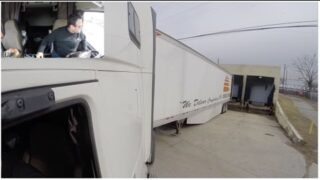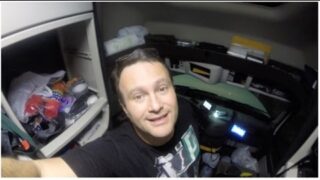Bacia de Campos: mar em fúria, mergulho profundo e luz misteriosa
0To extract oil, sometimes,
you have to face the raging sea. Even in superstructures
such as platforms or platform ships, the situation is still
frightening. This scenario, for example, occurred in the Campos Basin. But there are even more terrifying scenarios, like this one off the coast of Scotland,
in the dreaded North Sea. This other platform
is also suffering in the North Sea, 140 kilometers off the coast of Norway. Recently,
when visiting the Campos Basin. I tried to find out from
the onboard employees how they deal
with the ocean’s bad mood. My biggest concern
is exactly with stability. It doesn’t list to one side
or the other. It doesn’t enter the water. Basically as a ballast operator,
I am responsible for ensuring the
floatability of the platform. The Campos Basin is
between Cabo Frio and Espírito Santo. To get to the
exploration units, the best way is to board
at Macaé Airport. I am now boarding a helicopter
chartered by Petrobras to P-51, one of the most traditional
production units in the Marlim Sul Field, 175 kilometers from the coast. Along the way we can see
many extraction units. Coming now to P-51, in operation since 2009
1250 meters above the ocean floor. P-51 is a floating production unit, oil and gas processing and transfer submersible type. There are some other types
of platforms, such as the fixed one, which can be operated
for drilling or production and is supported by steel piles on the seabed in shallow waters
up to 120 meters deep. There’s also the FPSO, the floating production, storage and offloading unit, for its acronym in English.
the FPSO is a large tanker. The FPSO is a large tanker. The current production of the P-51 is
30,000 barrels per day. Platform P-51,
in the Marlim Sul Field, production began in 2009,
that is, we have been producing for 15 years. We have a project to extend the productive life that would go until 2034,
we would take it until 2048, 2050. If we consider the price of Brent
at around 80 dollars, making the conversions, we would have, more or less,
in terms of revenue that the P-51 Today it brings to the company,
to society, to the nation, 12 million reais per day. All the oil and gas
produced here is exported. In the case of oil, it is exported
via pipelines to an FPSO vessel A FPSO in this case, which receives
this oil in its tanks and then transfers this oil to
shuttle tankers, which are oil tankers, which invariably go to
our onshore terminals or even some for export,
to other countries. And the gas is also exported
to the land through pipelines, and all our gas here
goes to Cabiúnas. P-51 is 116 meters long
and 110 meters wide, the same as two soccer fields
like Maracanã. Part of the space is reserved
for employees’ free time. There is a games room, gym,
music studio and TV room. The restaurant offers some
special meals to entertain the staff on board. Everyone waits all week
for pizza day and barbecue day. Pizza is at night, on Wednesday night,
and barbecue is on Sunday during the day. Life on the platform increasingly
includes the participation of women. I started boarding
ten years ago. Ten years ago, the first ship I boarded,
it was just me and another radio operator. So we were only two women on board. Not anymore. Now we have several functions. We have mechanics, chemists… Here on this platform,
approximately ten women. So, it has changed a lot.
We are evolving more and more. And women working
in various roles. In general, employees
spend 14 days on board and then return
home. Life on the platform
is peaceful, as long as, of course,
the sea is calm. My first boarding
was a bit traumatic. But then, I learned a little,
to always have a full stomach. I take medicine
so I don’t get seasick. Nowadays I’m quite used to boarding. We are operating
here with the ship and there is a little rain
on the way. If we look here, It looks like a cyclone is forming. In the water too… there’s a little vortex forming here. When the weather starts to get bad, you need to take a series of actions on the platform. If any
abnormality occurs, we have the control system,
which will vary these parameters and be able to control
and stabilize the platform, if this occurs. The SS-type platform for
the crew member is very stable. It doesn’t rock much,
it doesn’t rock much, precisely because it works
kind of like a catamaran. Stability is a crucial point
for the safety of the structure. Accidents are rare. In September 2024, the P-19, in the Marlim Field, suffered an
accidental tilt during a maneuver. No one was injured. The platform was in decommissioning,
that is, it was being deactivated. One of the most serious cases of tilting occurred after three explosions
on the P-36, in the Campos Basin. On March 15, 2001, the platform, the largest in the world at the time,
sank, leaving 11 dead. But what if the sea gets really, really rough? There is a scale, the Beaufort,
that measures the fury of the tides. Sea Zero is the mirror image. At Sea 3, the wave
reaches one meter. From there on up, it starts to get rough.
Last on the list is Sea 12, hurricane-driven,
with waves exceeding 14 meters. P-51 is prepared
for the worst. Here in the Campos Basin,
it normally reaches 4, but it is unlikely to reach
a value of 5 or 6. But the project foresees
a hundred-year wave condition. A centennial wave is a design parameter
in which you take the data from the worst wave that has occurred in the last
100 years in the region. Probably around
10 to 12 meters. The rough sea changes
the routine on the platform. Diving for maintenance
of the structure is suspended. Human diving, for example,
we have some limitations. For example, up to two meters of wave
is the limit of human diving. So we have
some limitations. Very rough seas, high winds,
things like that, human diving has
a greater restriction. And even for the ROV
we have limitations there. We don’t operate
on our own in rough seas, mainly because of taking the ROV on and off the ship. To avoid risks, we interrupt operations
on days with rough seas. So today we do
these deep inspections with equipment that
we call ROV. Here, for example, at P-51, we are at a depth of 1250 meters. There are several wells, lines,
equipment. At the bottom, all the work is done by robots, with this ROV. For the shallow part,
only human diving. In the past, we also had saturation diving vessels. We used to dive up to 300 meters deep. Nowadays, we have abolished deep diving.
We have replaced everything with robots. Human dives used to reach impressive depths. Today, human dives… we are at this moment, for example, here on platform P-51,
with that vessel over there. The vessel docks
at the unit, divers go down
into the water and do the dive that today we call
shallow diving. It is a dive that goes to,
approximately, 40 meters deep. They do
interventions and inspections there. So, around the unit,
we use these vessels. I’m here at P-51, Petrobras oil platform. And it’s a region where
a lot of oil will still be extracted from here. So, here, on the platform,
we can come here a little down there… Down there we
have the boats, the work area. Here, permanent maintenance is necessary, because it is very close to the sea, salt spray,
and the material wears out a lot. We notice
that rust is quick. Contemplating the sea
brings us into a strong connection with the forces of nature. Employees report
sightings of whales, sharks, dolphins and
large fish near the platform. There are even records of
unexplained phenomena like this one in May 2024:
a light on the horizon coming from the bottom of the sea. On social media,
the video went viral. Some attributed the light to the reflection of the sun
from an American submarine and even an alien spacecraft. What a crazy light, bro. Ah, the sun died and went over there,
it didn’t go over here, no. The sun dies over there. The sun set over there. What’s that light over there? One of the most accepted explanations Would be luminescence
caused by living organisms. Although there is no
record of a previous case in the region. In 2018, for example, bioluminescent plankton
caused a spectacle on the beach of the Isle of Anglesey,
off the coast of Wales. The glow is a defense mechanism
against predators. In the Campos Basin
there is much more to be amazed at. The oil is stored
deep in the earth below the seabed,
and it’s not easy to extract it. The oil is in these little holes.
It’s this big — okay? — down there. 771 –> 00:13:28,157
The oil is in this little hole. And for me to remove the oil This little hole has to be in contact with this other one,
which has to be in contact with this other one,
which is called permeability. This is a rock called
coquina that has oil in it. And the oil is in the little holes. The little holes have to be connected
to each other. But here the porosity, the so-called little hole,
is much larger than the porosity here. If I have these little holes all
connected with oil, when I drill the well and the pressure up there
is lower than down here, this here is all thrown
up there. The oil is stored
under extreme pressure. When you dive,
doesn’t it feel like your ears are under pressure? There are 2,000 meters of water there. Imagine the pressure. You add another 3,000 meters
of sediment. So you have this down here,
with 3,000 meters of sediment, 2,000 meters of water
pressing it. It’s being pressed. The oil is here. You drill a well, what’s in here for pressure,
if it has enough charge to push the oil,
it’ll come out up there. Sometimes you need to
increase the pressure. If there isn’t this
pressure variation, I have to put pressure on the reservoir
to push the oil up there. If I come here and inject
something that pressurizes it, with water or gas,
oil starts to come out of the holes. The size of the rock that stores
the oil is enormous. It’s a mega rock. The height of this rock in Búzios, 200 / 300 meters high, all full of oil. Do you know how this oil
was formed down there millions of years ago? The formation of oil
is as follows: you take the sediment which has organic matter. If you take a mangrove today, then there
is a lot of organic matter. If you take that organic matter,
for some reason, bury it… what is burying it?
To fill it with stuff. The organic matter will stay trapped
there, but it will die. But it will die
and what will it generate? A gas. Depending on the temperature and pressure
it is subjected to, it will generate oil or not. So what is oil? It is a rock rich in organic matter,
which has been pressurized and heated. The rock that stores it,
however, is not the one that generated the oil. But it’s not this
rock that generated it. The rock that generated it,
that I’m talking about, is that mud from the mangrove,
where the crab is, which is a very simplistic
example. It is subjected
to pressure and temperature and, when it starts to squeeze
here, the oil starts to move here. It walked here,
found a little path and found this rock here and started
filling with oil here, underneath. So when he got up here
to leave, he found the salt. This is the pre-salt.
But why is it in plastic? Because when you put the salt in the
air, it picks up moisture and goes away. So I put it up here.
There was the generator down there, there was the path
and started filling it with oil. But the lid of the pan is here. Then when the lid of the pot here
began to fill, it filled, it kept filling,
it kept filling, it kept filling… The history of oil exploration
in Brazil begins in the first decades
of the last century. A study by foreign geologists found that the country
lacked large reserves, throwing cold water
on national aspirations. The first geological map of Brazil is dated 1919. The first well in Lobato,
in Bahia, was drilled. Oil was discovered. Petrobrás was created in 1953, with the goal of making
Brazil self-sufficient. Not giving up,
Brazil invested in the training of geologists, who would persist
in the search for black gold. A new study
showed that the oil was in the sedimentary basins on the coast
and not on the mainland. So, the formation
of the sedimentary basin occurs from the
opening of the Atlantic. Brazil and Africa were together
and then separated. And it generated sedimentary deposition
on the edge of this lake and on the other edge… The basins are on the edge. In the center now you
have the oceanic crust. The ocean is opening. Today we have
a unit in production. There are 27 units in the
Campos Basin, 337 wells. Today we are responsible for 20%
of all national production. It seems like a lot, but the region
was once responsible for 80% of Brazilian
production. So we are
revitalizing the Campos Basin. This is a big project. The project has to
invest 22 billion by 2028. There are 135 new wells. Vessels to launch the line
and also revitalize the fields. Revitalization means bringing in new units. Extending useful life means investing in
what you have so that it lasts longer. Instead of falling, you increase production. So we have an increase in production. By 2028, our projection is to
reach 600 thousand barrels per day. We have fields in the pre-salt,
but most of them are in the post-salt. And most of them are in
deep waters. Up to 1500 meters we
consider deep waters. The discovery of the Campos Basin
was a turning point for Brazil. It made possible the desired
self-sufficiency in oil. On November 22, 2024, production in the region
completed 50 years. Accumulated, since the discovery
at the beginning of production, in Enchova, until today, we have already produced 14 billion
barrels of oil equivalent, here in the Campos Basin. Based on the current price per barrel, around 72 dollars, this extraction would be equivalent today
to 1 trillion dollars.









